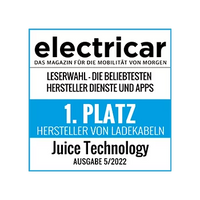20 Technical Starter Tips
Understanding the Model S also means understanding its technical aspects. Because you won't find that anywhere, we've put together the most important tips for new drivers here:
Tip 1
Electric motors develop full power right from the start
When you start, you have endless power. You leave everyone behind. And if you don't control your right foot in your joy, your tires won't last 3,000 km. And your driver's license won't last even that long. And, no joke: If you get a headache or feel dizzy in your Model S for the first few days, it's because of the crazy acceleration. But you get used to it and it soon goes away.
Tip 2
Understanding and using recuperation
Drive half a second more cautiously and you will hardly ever hit the brakes in normal traffic. You only drive using the accelerator pedal (for the linguists: power or accelerator pedal, but we already know the term accelerator and it doesn't sound so eco-friendly). The recuperation (recovery of electricity) relaxes you to the maximum. In rush hour traffic on the motorway or in the city, you no longer have that stop-and-go feeling that slows you down, you just float along. You arrive light and relaxed. Your business meeting will be more successful. (For all you safety freaks: Of course, the Model S has a motion sensor like your iPhone. Once you reach a certain deceleration value, your brake lights come on so that nobody crashes into your back.)
Tip 3
And then forget to keep your mouth open because of all the recuperation
I sped over the St. Gotthard. To be precise, over the Tremola: the old, cobbled stagecoach road. You get dizzy from the g's when accelerating and in the hairpin bends. OK, this ride was a bit pubescent. But it was awesome. And when you're speeding towards the hospice and the combustion engines are already gasping for breath at 2000 meters above sea level, even on the straights the motorcyclists fly past you like the stars past Captain Kirk. The consumption in a mountain race like this quickly reaches 600 Wh per kilometer.
But here's the thing: On the way down you get everything (EVERYTHING) back! You're still the fastest, but instead of braking away all the great energy, your Model S recuperates a fascinating amount. And down in the valley you have an average consumption of 220 Wh per km. That's the same as without the mountain. Let no one say that Switzerland has no view of the Mediterranean.
Tip 4
Efficiency decreases with increasing speed
Up to 130 you are really economical, corresponding to around 2.2 liters of petrol (even more economical at the American 55 miles, i.e. 88 km/h). At 150/160 you need a bit more power - but it's no different with a petrol engine. Constantly running at 200 really drains your battery and range. (And it's no different with a petrol engine, but no one is surprised when it suddenly consumes 35 liters instead of 12 - see AutoBild 1/14, "Petrol engines under full load consume 64l/100km").
Tip 5
Airy Resistance
The reason for the increased consumption is purely due to air resistance. As soon as it really grips and brakes (from a good 80 km/h), you gain time - but waste energy with no chance of recovery. So if you want to dramatically increase your range in an emergency, drive on country roads and reduce your speed to 60 to 80 km/h. Compared to driving on the motorway, your consumption will often be half or even less.
Tip 6
On the road, the car hardly reaches its limits
You won't reach the limits of either the chassis or the drive unit if you keep your brain switched on. The low center of gravity, the completely fade-resistant brakes, the long wheelbase and the endless power make the Model S a very fun car to drive with a wide, easily noticeable limit range on the outside. On the race track, after about two hours of racing, a break is called for.
You have to understand that the electric motor is running at full power all the time and it gets hot. The battery also gets warm when it is running at full power for hours. This process gets more intense the emptier it gets. If the remaining energy is below 25%, the cooling system has to work hard and at some point the Model S will reduce the maximum power to what feels like 150 hp. Then you just have to let the Porsche pull ahead on the race track. (But not before then.)

Tip 7
Using the battery correctly
First you need to know: your Model S is like your iPhone. When you get home (or maybe even to the office), just plug it in. There is no memory effect, just keep charging - and always to a good 80% (i.e. in Normal Mode). That way you have a full car every morning. If you are planning another trip, charge it completely beforehand by selecting Range Mode (Max Range). In general, your batteries prefer to work (and last the longest) between 80% and 20% full.
If you need more, fill it to 100% (switch on Max Range), they like that better than being run down to 0%. And it's best to fill it up in the hours before you leave. Pumping the battery to the brim over days (and possibly in the summer heat) is a no-go. And if you arrive at your destination completely empty, plug it in quickly. Leaving it empty is also a no-go.

Tip 8
Overcoming Battery Fears
Important to know: Tesla's battery management is really top-notch. No matter how often you charge at superchargers, the batteries don't mind. No matter how often you plug in, the batteries hardly lose any power. An 8-year battery guarantee speaks for itself. If you pay attention to the power consumption, you'll notice that charging with more amps and more phases is more effective than sucking 8A from a household socket. The main reason is that the charging process is completed more quickly and the car therefore doesn't have to heat or cool the batteries for as long to charge.
Tip 9
Thrills and precision landing
What makes long journeys in the Model S particularly entertaining and drives passengers to the brink of a nervous breakdown: precise landings at the next supercharger. Don't let the Model S software scare you when it predicts that you will arrive with -3% battery capacity as a precaution. Simply compare the remaining distance on the navigation display with the remaining battery range and adjust your driving speed so that you turn into the rest area with exactly 0 km of remaining range. I've tried it myself many times - it works perfectly. (But then don't wait to charge.)
Tip 10
But don't miss the perfect landing
It only gets embarrassing when you get below 0. We've already been told that a few km below zero are usually still possible - but there's no guarantee. In any case, we know of a fearless S driver who managed -23 km. Then the car showed "pull over to the right" and definitely switched off. That's really stupid, because then you have to tow it to the service center. So it's better to slow down beforehand, head to an inn and charge it up with the Juice Booster 2 at their chip can.
Tip 11
Install and use the iPhone app
Pre-cool it, have someone guide you to the parked car, honk at the gawking teenagers using the app, control the charging process, download the app to your wife so that she can see in real time when you're home and can prepare the aperitif... and, of course, we won't tell anyone, show it all to your friends and secretly enjoy the way their jaws drop and they think "ugh, my car is old."

Tip 12
Download and enjoy updates
"This car is getting better and better," says Elon Musk, the founder of Tesla. New updates are regularly installed overnight in the car, which is always online. And when you arrive in the morning, your car can do more than it could the evening before. You can find the history of the releases here.
So far, however, there is no information available before the release. So it is possible that a security-related restriction may be secretly revealed as a pig in a poke. That really doesn't have to happen.
Tip 13
Speed kills
Not just people, but also range. What you tend to ignore in a petrol car is mercilessly visible on the detailed display* of your Model S. Acceleration orgies and high speeds eat into your range. It's no wonder that the Americans introduced a speed limit of 55 mph (88 km/h) during the oil crisis. If you drive at 200 or more for a long time, your electric motor will eventually get warm. The S recognizes this and puts a nice dashed power limit line on the kW scale.
* Speaking of minute details: The speedometer on your Model S is very accurate. It usually only shows 1 km/h more than you are actually driving. This means: If you drive in a 50 km/h zone like you used to with a little extra speed, e.g. 55 km/h, and come across a modern speed camera with a tolerance of just 3 km/h, then you will have a net speed of 51 and a ticket in your mailbox.
Tip 14
Cold also kills
Your Model S is tougher than your iPhone, but standing around in the cold with a fairly empty battery will lead to a foreseeable loss of performance. That's why your car will tell you when you park it that you should think about charging it. At 0 degrees Celsius, you can easily lose 20 kilometers of range overnight. The below zero, the less you lose (not a nice German phrase, but it makes sense). And importantly: you must not leave your car in temperatures of -30 degrees and colder for longer than 24 hours, otherwise your 8-year battery guarantee will expire (European guarantee conditions, page 3 or sheet 6).
Tip 15
little line on the wall
The aforementioned limiting lines in the kW scale occur in the following situations (and they disappear again by themselves):
► On the upper (benefits) scale:
- when the engine or battery becomes hot due to high power consumption
- when the battery is still cold and is first preheated
- when the battery is quite empty and is therefore being protected
► On the lower (recuperation) scale:
- when the battery is still cold and is first preheated
- when the battery is full and has no space for recuperation (note: in this case the braking effect is also much weaker than normal)
Tip 16
Let there be light
If you don't adjust anything, the daytime running lights will always light up at the front - and it will be dark at the back. Unless the twilight sensor detects darkness, then the lights will come on all around. Thanks to extremely sensitive electronics, this happens faster when entering tunnels than with any other car. After what feels like 2 meters in the tunnel, your Model S already has the correct lighting, while Audi drivers are still waiting for illumination (although the headlights alone don't help here either).
When you adjust the windshield wipers, the lights come on at the same time (including the rear ones) - but they switch off again after a few minutes if the sensor does not detect night. In diffuse light, it may be advisable to set the lights to ON yourself via the display. When parking, this switch automatically goes back to AUTO.
If your recuperation starts suddenly or reaches a certain deceleration value, then your brake lights (or at least your Model S) will come on. Don't believe it? Then check this in older Teslas: Press the battery symbol on the screen. On the car displayed you can see all the light states of your car in real time. In all new Teslas, the car that is permanently visible on the dashboard shows you the light states in real time.
And another insider tip that is not mentioned in any manual. This is how you activate the parking lights: Press CONTROLS on the bottom left of the large screen, get out and then switch on the dipped beam with no one in the driver's seat. This way the lights stay on even when the vehicle is locked. The fuel consumption is low, by the way.
Tip 17
Charging made easy
A few important things for charging newbies:
- To open the charging flap, press "Controls" on your screen and then "Charge Port". Or press the tailgate on your car key for 5 seconds. Or press our Charge Port Opener.
- Public charging stations often have somewhat complicated start-up procedures. Try to think like an absent-minded engineer, maybe you'll see through the logic. It's not uncommon for you to have to deactivate emergency stops pressed by jokers first.
- It is easier to use a mobile charging box connected to normal sockets (see chapter Charging and Driving.
- And if you want to unplug the car again after charging is complete, open the car by double-clicking on the roof of the car key or by pressing the trunk opener button for 5 seconds. (If you have set it to "open when approaching", you still have to double-click the key or shout "unplug!" at least three times for your S to unlock the charging plug.)
Tips for charging at a Supercharger:
- You can find a great overview of all active Superchargers here. Tesla's own fast-charging stations that are planned or under construction are also visible and useful for travel planning.
- When using superchargers, pay attention to the numbering on the columns. 1A and 1B usually share a stack of rectifiers. So if someone is already on 1A, don't choose 1B, because that would halve the power of your two charging processes. Instead, go for 2A - assuming 2B is free, of course...
- You will travel most efficiently if you use the battery between 0% and almost 70% charge on long journeys, because that is when your Tesla charges by far the fastest. If you fill it up more, the charging process slows down massively.
Tip 18
cleaning
If you want to maintain your Model S by hand, go ahead. I personally drove and drive all my cars through the car wash. It's easier and scratches will appear sooner or later anyway. But with the electric S you should note:
- At the beginning of the conveyor belt, put the car in N as normal (just lightly touch the gear selector. Of course, DO NOT press the silver button for the parking brake. And of course DO NOT activate the tow mode, especially because deactivating it at the end of the car wash takes far too long.
- While you are being pulled through the car wash, just sit still. Your S has a sensor in the driver's seat. Without any weight on it, the car immediately jumps into "P". As another S driver told us, in this case the entire car wash with all ten cars in it will stop immediately, a soaking wet Balkan employee will knock on the window and ask annoyed "Did you brake or what??". So, to be on the safe side, postpone cleaning the interior until later.
- At the end of the system, when the traffic light turns green, briefly press the brake and quickly engage "D" and drive away.
- If someone dries by hand, don't forget to extend the door handles so that no water stains appear.

Tip 19
All about cycling
Did you choose air suspension? Then before changing the wheel, be sure to read the manual carefully to find out how to put your car into wheel change mode. Otherwise, your suspension will run amok and void your warranty.
And a tip on the correct air pressure in the tires, because we keep hearing from S drivers that they can't turn off the error message "too low air pressure" and that the sensors are probably broken. Almost no one realizes that the message means exactly what it says: too low air pressure. 21-inch wheels need 2.9 bar, 19-inch wheels even need 3.2 bar. That's not a beach buggy, that's a sports car, right?
Tip 20
Estimate charging power
With the Model S, it is very easy to estimate the expected charging time, because the following simple rule of thumb works purely by chance:
Amperes * number of phases = kilometers charged per hour.
Example 1:
Charging at Schuko socket with 13A * 1 phase = approx. 13 km per hour charging time
Example 2:
Charging at CEE32 socket with 32A * 3 phases = approx. 96 km per hour charging time
Example 3:
think of a task yourself and annoy your partner with it
The thing about batteries
That should actually be in a Tesla Quick Start Guide. Because as someone switching from old drive technology, these are exactly the questions that interest them:
How do I make the most of my battery capacity?
Here are a few simple but important basic rules:
- The most gentle driving is when your batteries are between 10% and 90% charged. This is why the Model S does not charge completely in normal mode.
- If you need more power, the batteries prefer to be fully charged at 100% rather than being empty at 0%.
- However, full charging to 100% should only be done shortly before starting (ideally a few hours before); pumping the battery to the brim for a longer period of time will cause the battery to age prematurely.
Leaving the car standing around with only a few percent of its charge on it is just as bad. So when you get to your destination, just plug it in, no matter how small the socket is.
But this is nothing new, you already know all this from your mobile phone, right?
- The bricking protection (protection against the batteries becoming baked together due to total draining) cannot be touched.
- The Zero Mile Protection is designed to ensure that the car effectively continues to drive for a few kilometers even when the range is shown as 0 km. However, we have reports that this emergency reserve is limited to a few kilometers and that someone has, for example, broken down when the range was shown as -20 km (which, however, corresponds to about 5 kWh if we assume 250 Wh consumption per kilometer).
- 67.4 kWh of available energy in normal charging mode therefore corresponds to a range of around 340 km with moderate driving and a consumption of 200 Wh/km (easily achievable in summer). Make sure you select "typical range" in the settings of your Model S, then your car will extrapolate your driving style and the range calculation will be much more reliable.
- 75.9 kWh in range charging mode corresponds to a range of around 380 km. In winter, consumption can rise to 250 Wh/km. In very low temperatures or with excessive heating, consumption can even reach 300 Wh/km, which reduces the range to around 250 km at worst.
What do my battery cells actually look like?
There are around 8,000 individual battery cells in the floor of the car. These correspond almost exactly to the small rechargeable batteries used in notebooks, for example. They are slightly larger than AA batteries (similar to the green cells in the picture) and are grouped together in blocks that are separated from each other. The art and competitive advantage of Tesla lies in connecting these cells in a well-guarded manner and controlling them with an extremely efficient control system. This allows charging faster, more power to be drawn at once and at the same time the lifespan of the batteries can be increased massively. Most of Tesla's batteries are recycled.

What else you should know as a Tesla driver
Nikola Tesla (1856 - 1943) was an electrical engineer who made numerous inventions in the field of alternating current technology during his life. Among other things, he contributed to the use of alternating current technology for energy transmission in today's power grid, rather than direct current technology as developed by Edison. Tesla's inventions include the Tesla transformer for generating alternating currents at high frequency, the first radio transmitter and the first remote control. Tesla worked throughout his life on transmitting electromagnetic energy wirelessly using electromagnetic waves. He had already considered using the reflection of radiation from the earth's atmosphere to transport energy over long distances along the earth's surface.
The magnetic flux density, which in physics is abbreviated by the letter B, is measured in the units Gauss or Tesla.
The following applies: 10,000 Gauss = 1 Tesla. A magnetized ferromagnetic material becomes a magnet whose strength is described by the remanence. Gauss and Tesla are therefore also the units of the remanence of a permanent magnet.
1 Tesla is therefore one Newton per ampere and per meter. This means that 1 Tesla corresponds exactly to the magnetic flux density that exerts exactly 1 Newton of attraction on a conductor 1 meter long through which 1 ampere of current flows - due to the magnetic effect of the current in the conductor.
Source and copyright: Franz-Josef Schmitt, compendium on www.supermagnete.ch / Webcraft AG

More exciting information about Nikola Tesla and his life's work:
Wikipedia page about Nikola Tesla
Wikipedia page about Wardenclyffe Tower
Highly interesting Matura thesis about Tesla by Dominik Wyser
And what Elon Musk said ...
"People will look back on gasoline engines in a few years, just as we look back on steam engines today, and say:
It was a good time, but it's over and it's never coming back."
Elon Musk, CEO of Tesla Motors.













